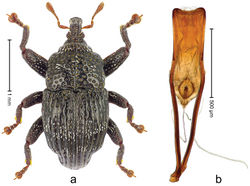Trigonopterus athertonensis
| Notice: | This page is derived from the original publication listed below, whose author(s) should always be credited. Further contributors may edit and improve the content of this page and, consequently, need to be credited as well (see page history). Any assessment of factual correctness requires a careful review of the original article as well as of subsequent contributions.
If you are uncertain whether your planned contribution is correct or not, we suggest that you use the associated discussion page instead of editing the page directly. This page should be cited as follows (rationale):
Citation formats to copy and paste
BibTeX: @article{Riedel2016ZooKeys, RIS/ Endnote: TY - JOUR Wikipedia/ Citizendium: <ref name="Riedel2016ZooKeys">{{Citation See also the citation download page at the journal. |
Ordo: Coleoptera
Familia: Curculionidae
Genus: Trigonopterus
Name
Trigonopterus athertonensis Riedel sp. n. – Wikispecies link – ZooBank link – Pensoft Profile
Diagnostic description
Holotype (Fig. 4a). Length 2.45 mm. Color black; antenna and tarsi ferruginous. Body elongate, with distinct constriction between pronotum and elytron; in profile convex. Rostrum with median costa and pair of submedian costae ending in apical third; intervening furrows with rows of coarse punctures each containing one mesad directed narrow seta; base dorsally protruding, projecting from profile subangularly; epistome posteriorly with transverse ridge. Forehead coarsely punctate-rugose. Pronotum with subapical constriction; disk coarsely punctate; with median costa; punctures each containing one seta, few with white scale. Elytra with striae deeply incised, containing few coarse punctures; intervals costate, sparsely punctate, in basal third partly transversely confluent; with indistinct transverse bands of sparse white scales; base markedly bisinuate. Legs. Femora densely punctate, with transverse band of sparse white scales. Profemur with subbasal callus anteriorly projecting. Tibiae subbasally with dorsal angulation; metatibia with suprauncal denticle. Abdominal ventrites 1 medially concave; abdominal ventrite 2 swollen, especially laterally; ventrite 5 in basal half concave, coarsely punctate. Penis (Fig. 4b) with sides of body weakly diverging to subtruncate apex; transfer apparatus compact, subrotund; ductus ejaculatorius without bulbus. Intraspecific variation. Length 2.45–2.68 mm.
Material examined
Holotype (ANIC): ARC4041 (PCR failed), Queensland, Mt. Fisher, 7 km SW Millaa Millaa, S17°34', E145°34', 1100 m, rainforest, litter, Q.M. Berlesate No. 409, 27-IV-1982. Paratypes (ANIC, QMBA, SMNK): Queensland: 1 ex, same data as holotype; 2 exx, Mt. Fisher, 7 km SW Millaa Millaa, S17°34', E145°34', 1050 m, rainforest, litter, Q.M. Berlesate No. 412, 27-IV-1982; 1 ex, Mt Fisher, summit, 17°34'S, 145°33'E, rainforest, 1360 m, sieved litter, Berlesate 991, 08-II-1999.
Distribution
Queensland: Mt. Fisher.
Biology
Sifted from leaf litter in primary forest.
Etymology
This epithet is an adjective based on the name of the Atherton Tablelands, where the species occurs.
Original Description
- Riedel, A; Tänzler, R; 2016: Revision of the Australian species of the weevil genus Trigonopterus Fauvel ZooKeys, (556): 97-162. doi
Images
|
